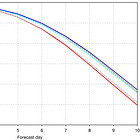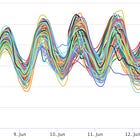Open-Meteo is excited to announce the arrival of GraphCast, a groundbreaking machine learning weather model from Google DeepMind. You can explore its forecast data using the Open-Meteo weather API and compare forecasts from different open-data weather models.
This development marks a significant leap forward, with GraphCast being the second AI weather model available on Open-Meteo, complementing the existing AIFS model from ECMWF.
Google DeepMind’s GraphCast
GraphCast is a weather forecasting model developed by Google DeepMind. It leverages machine learning techniques to generate weather predictions. Unlike traditional numerical weather models that rely on complex physical equations, GraphCast learns patterns and relationships directly from data.
Essentially, GraphCast analyzes vast amounts of historical weather data to recognize patterns and correlations. It then uses this knowledge to make predictions about future weather conditions.
GraphCast was trained using ERA5 data from the ECMWF Copernicus project, which is based on the ECMWF IFS weather model. Despite being a machine learning model, GraphCast heavily relies on and learns from classical weather models. Therefore, to utilize GraphCast, users still require data from classical weather models.
Although Google released the source code of GraphCast several months ago, real-time forecasts were unavailable. Users needed real-time forecast data from the ECMWF IFS model to run GraphCast, which necessitated purchasing a costly commercial license from ECMWF. With the recent release of ECMWF IFS data as open-data in 0.25° resolution last month, running GraphCast would now be feasible using open-data from ECMWF, but it would still be fairly complicated to run GraphCast operationally.
However, the American weather service developed an operational GFS GraphCast forecast and continues to provide forecasts as open data.
NOAA GFS based GraphCast
At its core, GraphCast is driven by data from the National Oceanic and Atmospheric Administration (NOAA), utilizing the Global Forecast System (GFS). Available as open data on Amazon Web Services (AWS) in GRIB format, GraphCast is still in the experimental phase, and users should remain vigilant for potential outages.
The model is updated four times a day with a spatial resolution of 0.25° and 6-hourly time steps, offering forecasts for surface-level variables like temperature, pressure, clouds, precipitation, and wind. Furthermore, it provides atmospheric data on 37 pressure levels, encompassing temperature, wind, humidity, and cloud cover. However, it falls short for energy or agriculture applications due to the absence of solar radiation or soil properties and the limitation to 6-hourly time steps.
Weather data archives date back to February 5th, 2024, but be prepared for the storage demands – a single model run reaches 28 GB. With 4 updates a day and 65 days of data until today this adds up to 7.3 TB. All data from 5th February onwards is integrated into Open-Meteo APIs and you can get instantly data for single locations instead of downloading all raw data.
GraphCast Training Weights
GraphCast's forecasts are impressive and challenge classical weather models, showcasing the immense potential of AI in weather prediction. However, it's worth noting that the model is currently trained on ECMWF ERA5 data while initialized with GFS data. This can lead to slight inconsistencies.
Running an AI weather model doesn't require significant computational resources, as a single GPU is sufficient for calculations. In contrast, a traditional numerical weather model necessitates a supercomputer to simulate weather forecasts.
However, training an AI weather model is resource-intensive, similar to training large language models such as Chat GPL or Google Gemini, often requiring hundreds or even thousands of GPUs. Conversely, making adjustments to classical weather models could be as straightforward as modifying an equation in the source code.
This reversal of training and simulation time presents an interesting challenge for meteorologists and data scientists striving to enhance AI weather model forecasts even further.
To address the issue that GraphCast was trained on a different weather model, NOAA is currently engaged in training machine learning weights derived from its archived GFS weather forecasts. An update might already by available end of April and improve accuracy of GraphCast forecasts.
Ensemble Forecasts based on GraphCast
Given the minimal computational demands for weather simulation with an ML weather model, NOAA is exploring the utilization of GraphCast for ensemble weather models. These models provide not just one deterministic forecast but numerous perturbed forecasts, estimating the potential range of weather development under slightly varied initial conditions. This approach, often referred to chaos theory or the butterfly effect, enhances our understanding of weather dynamics and estimates the uncertainty in weather forecast models.
It is yet unclear if and when a GraphCast ensemble forecast could be available, but an integration into the Open-Meteo Ensemble API, which already offers hundreds of perturbed forecasts, could be welcomed addition.
As we continue to unlock the potential of AI in weather forecasting, GraphCast stands as a testament to the possibilities of technology-driven innovation. Its integration into Open-Meteo underscores a commitment to democratizing access to cutting-edge weather data and analytics.
For those eager to stay informed on further developments, subscribing to Open-Meteo ensures timely updates on GraphCast and other advancements in weather forecasting technology. With each update, we move closer to a future where accurate weather predictions are not just a possibility, but a reality shaped by the convergence of human ingenuity and machine intelligence.





